Marketing automation is an essential tool for businesses. It streamlines marketing efforts, to increase efficiency, and drive growth. When you have automation tools in place to deal with repetitive tasks, you can…
- Save time and money
- Focus on more pressing and high-value tasks
- Create personalized experiences for clients
- Learn more about your customers’ behaviour and journey
A good marketing automation plan can also increase engagement, nurture leads, and finally, boost your revenue. The best part is it works for every business, large or small. Taking care of operational tasks and letting your marketing team use their energy on other projects.
Research by Hubspot showed that 76% of businesses use marketing automation and according to Ascend2’s 2023 report on marketing automation trends, 9 out of 10 marketers say it has helped them achieve their goals.
In email marketing, you can send personalized email campaigns to customers or prospects at specific times, based on certain triggers or actions. These triggers can start simple, such as signing up for the newsletter. Then, become more specific, such as clicking on a specific link in a previous campaign.
Here, you will learn some of the best practices (and benefits) of using marketing automation in your business.
- Set clear objectives
- Create high-quality content
- Test and optimize campaigns
- Understand behavioural segmentation
- Focus on dynamic groups
- Map your lead flow
- Use an effective lead capture strategy
- Integrate marketing automation with CRM
- Monitor the performance metrics
- Track your email reputability to avoid being tagged as spam
1. Set Clear Objectives
Before setting up your automation strategy, decide on your goals. Having clear and measurable objectives is key. As time goes by, you might need to make adjustments to your strategy. When this happens, your goals will keep you focused during the process and help you understand the results.
So, the first step to starting a quality marketing automation is to decide your end goal. Is it…
Increasing sales?
Generating new leads?
Improving customer retention?
Likewise, when planning your email marketing automation, reflect on how it can help your overall marketing and business goals. Remember: Never hit “send” without a purpose behind that email.
2. Create High-Quality Content
Creating quality content lies at the heart of great marketing automation. Whether it’s an email, landing page, or social media post, you must always deliver valuable and relevant content. Invest some time into creating original content — and you can even mix it with user-generated content (UGC) — to build a closer relationship with your clients.
What qualifies as “high-quality content”?
Many think “high quality” content has a high production value. In reality, great content is the one that resonates with your target audience’s interests, pain points, and aspirations. This is why you might spend a lot of time working on one piece of content and it doesn’t perform that well. Whereas, another one that took 5-10 minutes reached an all-time high engagement.
In the end, your content must create connections with current clients and prospects. To achieve this, spend some time learning about them — what they like, their needs, who they are, and what resonates with them.
Take Infinum as an example: they develop digital products and solutions. They created the Design Islands project to connect with other designers and discuss projects and creative solutions. On the project newsletter, they shared tools, resources & inspirational content. All are relevant pieces of content and links for their target audience.
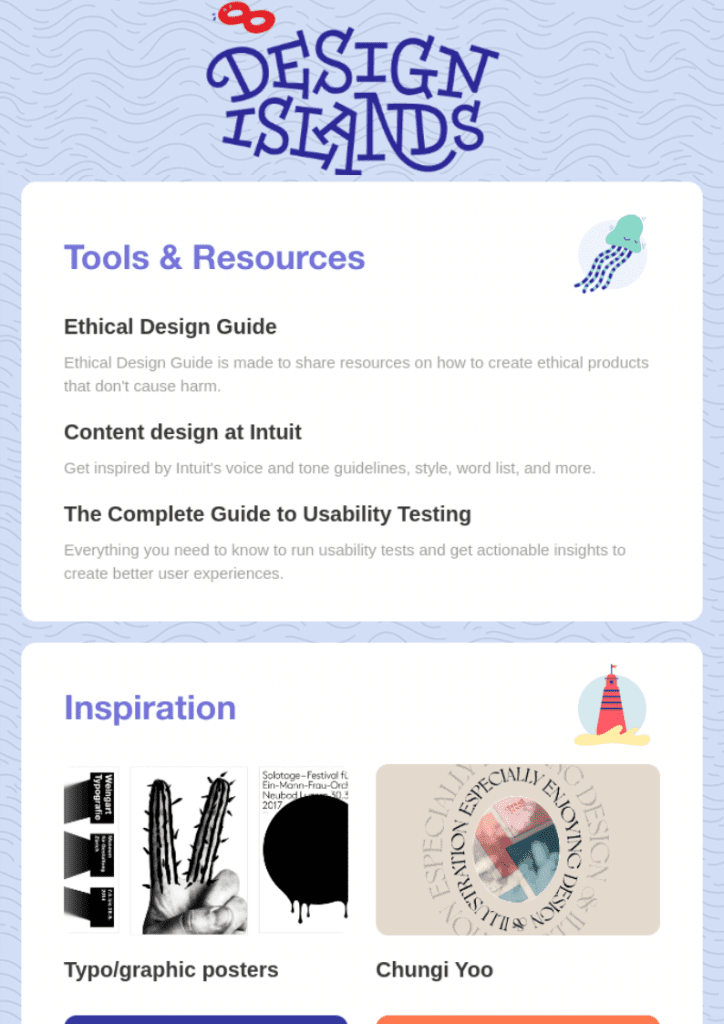
Source: Infinum newsletter
3. Test and Optimize Campaigns
Finding the best solution might take some testing and optimization. You can test several elements such as subject lines, email content, calls to action, and so on.
You can gain valuable insights from testing, especially about the wording that resonates best with their audience. In email marketing, the right words can help you improve:
- Open rate
- Click rate
- Unsubscribe rate
- Bounce rate
Pro tip: Take some time to learn more about the most important email marketing KPIs.
Analyze the results of these tests to data-driven decisions. Then, you can refine your campaigns, enhance engagement, and maximize ROI over time.
4. Understand Behavioural Segmentation
Behavioural segmentation means organizing your contacts into groups based on the way they interact with your business. This practice allows for more targeted and personalized communication. With a segmented audience, you can apply different strategies to target engaged clients and those in the initial contact stages.

Netflix is great at behavioural segmentation! They analyze how each user interacts with their titles — what they watch, what is added or removed from their watchlist — and send tailored emails to their preferences and tastes.
For demographic segmentation, you would use data points like age, location, gender, income, marital status, nationality and others, to organize your contacts into bigger groups.
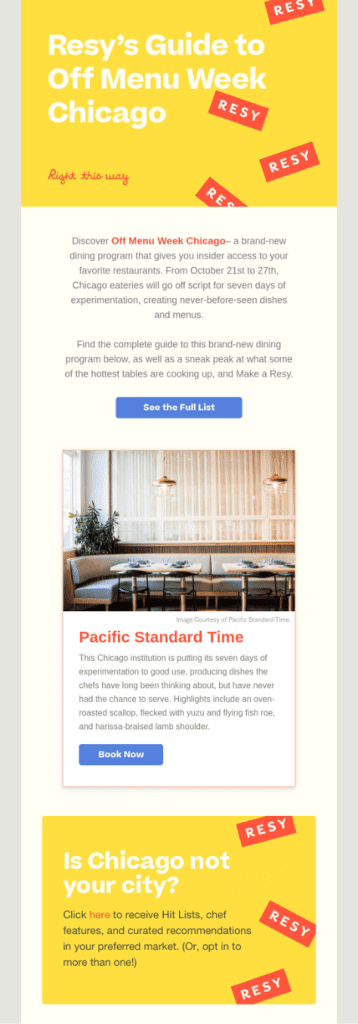
As an example, Resy, a restaurant reservation company, uses location to segment its audience and send campaigns based on the city they live in. They go a step further: they have added a block of content where the person can choose to “relocate” (change their location data) to receive emails about the city they live in.
Behavioural segmentation can explore different aspects of your relationship with each customer. If you have a SaaS company, you can use usage-based segmentation. That means you will organize contacts into heavy, medium and low usage groups. You decide what means to be a heavy, medium or low user of your services or products — maybe heavy usage is every day, while low usage is once per week.
Heavy users are more likely to be interested in more updates about new features or offers. Whereas low users might want fewer updates and other types of content that will increase their interest in your brand.
At the end of the day, segmentation — whether it is behavioural or not — is all about understanding your audience. When you do that, you have the tools to create an experience they will appreciate.
5. Focus on Dynamic Groups
On the same note of behaviour segmentation, let’s discuss dynamic groups.
Regular static groups are formed manually, i.e., you add the contacts manually. When you segment your mailing list with dynamic groups, it means contacts will be added or removed from a group based on certain criteria. This means the group is always changing.
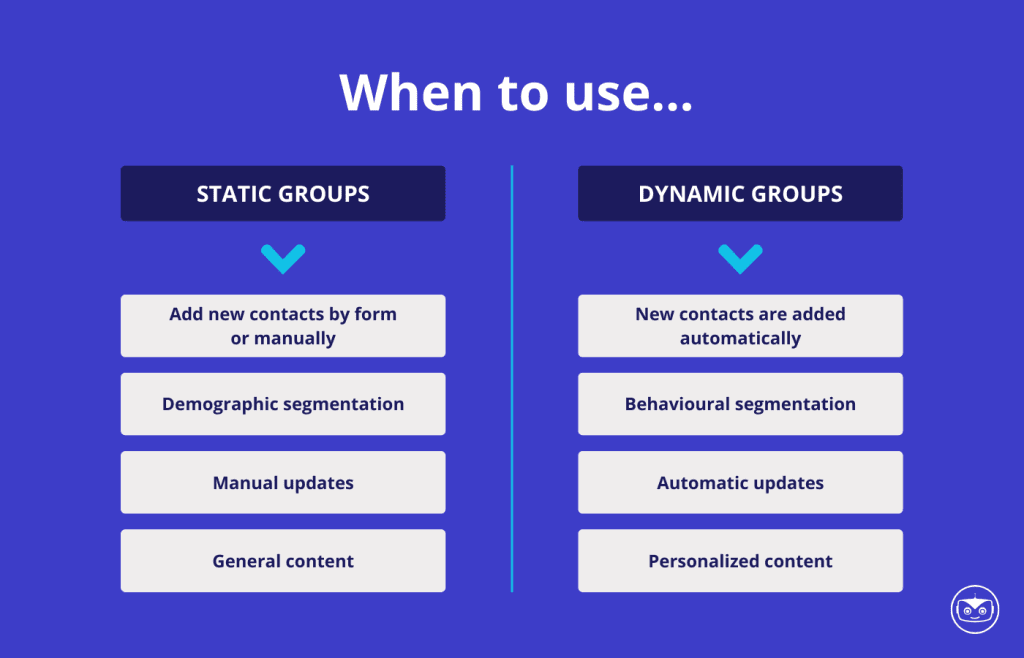
This is a great tool to complement behavioural segmentation as it creates that custom experience clients are looking for and saves you a lot of time. Instead of generic emails to all contacts, create dynamic workflows that people join or leave based on their actions.
Each contact can receive the right message at the right time while you are dealing with other tasks. This way, your business can nurture leads more efficiently and increase conversion rates.
6. Map Your Lead Flow
To make your segmentation strategy work, map your lead and customer flow to ensure a smooth journey for leads and customers. Again, this involves understanding your audience.
To map a good journey and use it in your email marketing strategy, learn about the stages a contact goes through, from initial contact, all the way to conversion and beyond. You can then find potential bottlenecks, and touchpoints to optimize and tailor your automation strategies.
Start simple: think about the basic stages such as awareness, consideration, decision, and retention. Then, study how each contact moves through each stage and what actions they take along the way. This will help you create automated workflows that will guide leads through the funnel in a seamless way.
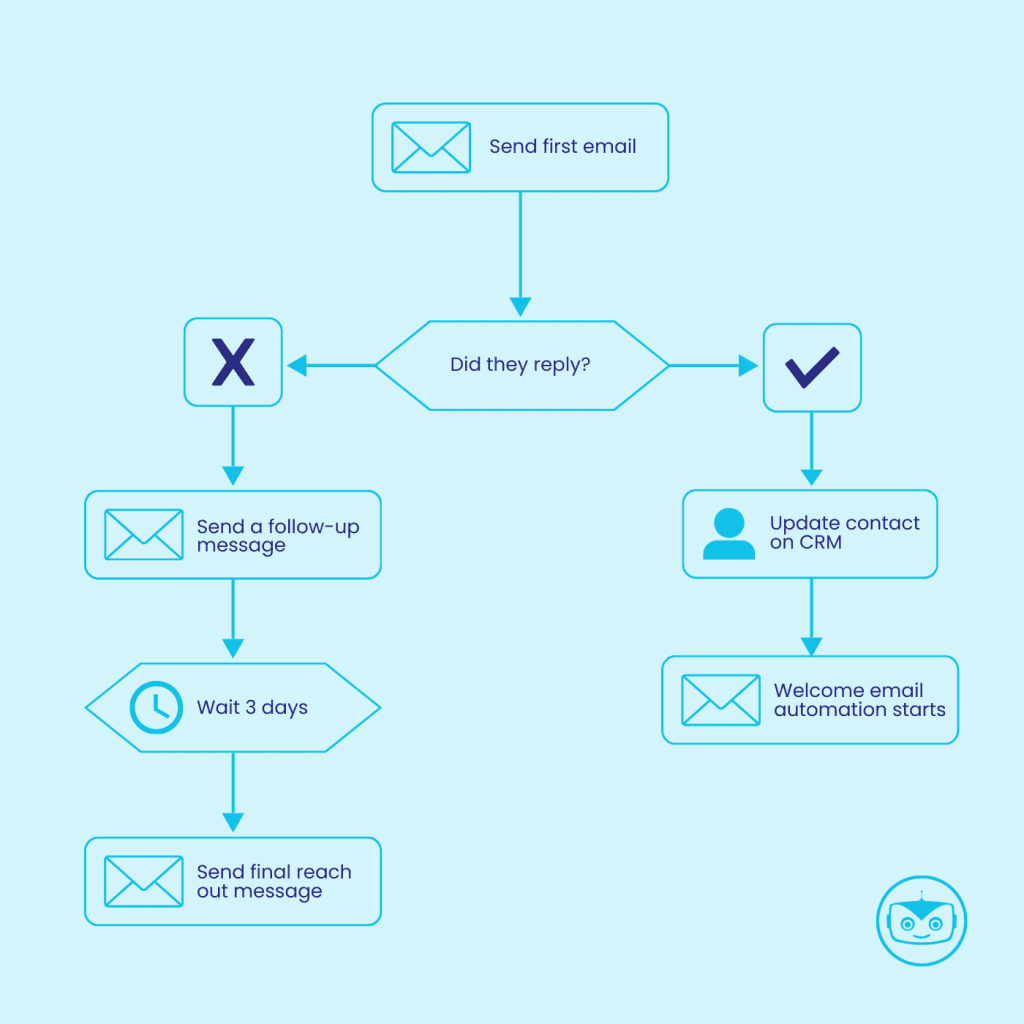
Pro tip: Review your map regularly to update it based on behaviour changes. A great (and effective) automation flow evolves as your business grows.
7. Use an Effective Lead Capture Strategy:
A good lead capture strategy is the cornerstone of successful marketing automation. After all, the goal of marketing automation is to make processes, like getting new leads, less time-consuming.
Without a way to capture those leads, you won’t be able to nurture them through your automated workflows. One of the best ways to do so is to offer valuable incentives that will make those potential leads want to share their information.There are several ways you can collect new leads: pop-up forms, demo plans, offers, and free resources, also known as lead magnets.
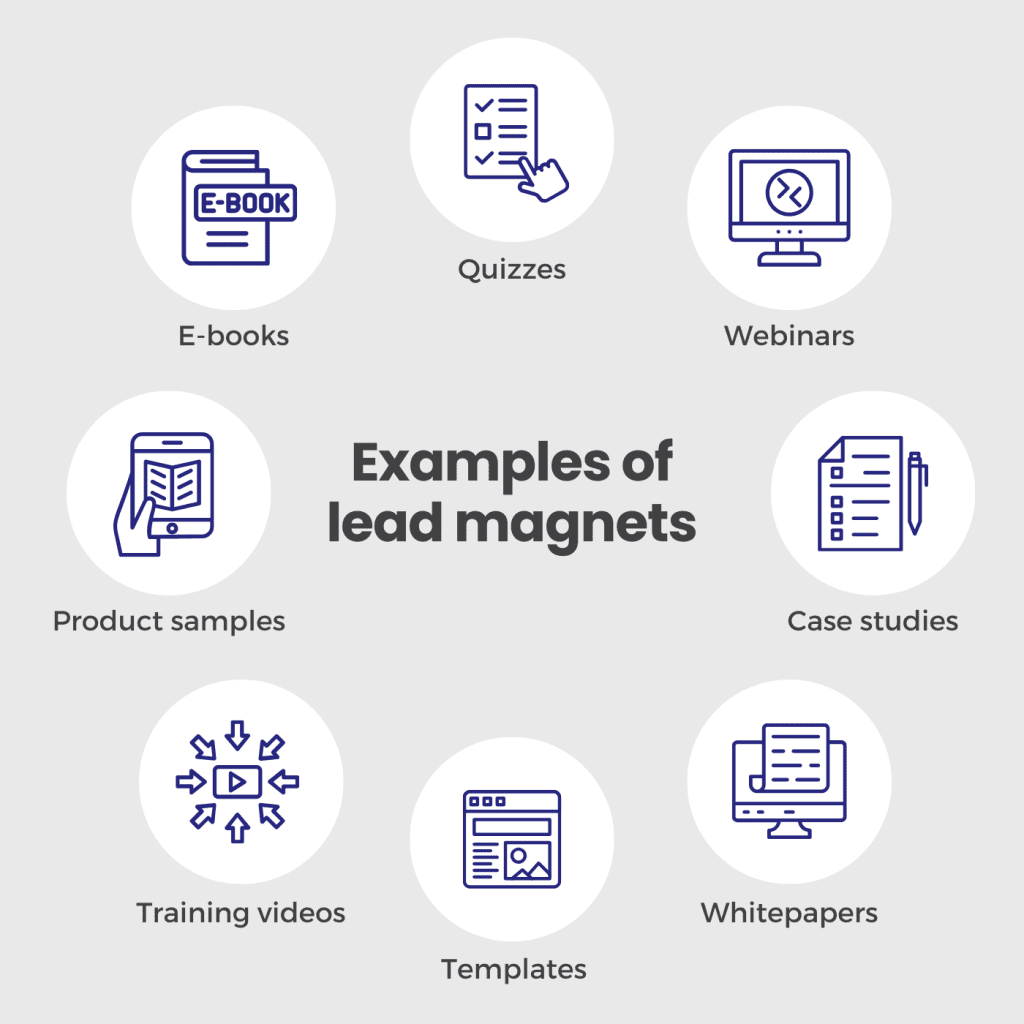
Keep forms short and simple, asking for only essential information to increase conversion. Later on, you can use other features from your email marketing software to collect more info about your contacts. If you’re using Cyberimpact, you can use micro-surveys or update a profile form as a simple solution to learn more about your audience.
Once you’ve captured new leads, make sure that their information is seamlessly integrated into your marketing automation platform to trigger automated workflows.
8. Integrate Marketing Automation with CRM
Now, you are in the final stages of making your marketing automation strategy. The next great step that will save you a lot of time is integrating your marketing automation platform with your CRM (customer relationship management) system.
By syncing data between these two systems, you can have a unified view of your leads and customers. Also, you can track leads’ interactions across channels, from initial engagement to conversion and beyond. By doing so, you can put into practice the segmentation and personalization strategies you’ve learned in this post so far.
With integration between your marketing automation and CRM, your sales teams can access valuable insights and context about leads. You can use Zapier, a great automation tool, to connect your Cyberimpact account with several CRM software. With this integration, you can have new contacts added to your CRM when they sign up from a specific form, easily update your static and dynamic groups and more.
Integrating tools means a more coordinated strategy between marketing and sales and increases your business’ overall performance.
9. Monitor the performance metrics:
To make sure your strategy is running smoothly and working (!), you need to monitor your marketing analytics. Track your key metrics and KPIs (key performance indicators) to gain valuable insights into the effectiveness of your campaigns and workflows. This is a crucial step to make your decision-making process more data-driven.
Some essential marketing analytics you should monitor include:
- Open rates
- Click-through rates
- Conversion rates
- Engagement metrics (e.g., time spent on site, pages viewed, clicks, replies)
- ROI and revenue generated
Regularly analyze these metrics to identify trends, patterns, and opportunities for optimization. Feel free to experiment with different tactics and strategies, and measure their impact on your key metrics to adjust your strategy.
10. Track your email reputation to avoid being tagged as SPAM
Finally, to have your marketing automation strategy bringing in results for your business, you need to keep an eye out on your email reputation — also known as your sender’s reputation.
Your sender’s reputation is the score given by email service providers (like Gmail, Yahoo, and Outlook) on how likely you are to send quality emails instead of SPAM. Being tagged as spam can severely impact your email deliverability.
When you use Cyberimpact as your email marketing software, you can see the number of spam complaints for each email sent. With this, you can monitor which emails got more complaints and study the reasons.

You can also use the Google Postmaster tool to monitor your email metrics and adjust your next steps to make sure your emails and workflows are reaching your audience’s inboxes. Following the new 2024 deliverability rules by Gmail and Yahoo, a good spam score is between 0.1% and 0.3% (i.e. three spam complaints per 1,000 sent emails).
If you find that your reputation is low, there are several steps you can take to change that scenario:
- Deliver high-quality and relevant content that resonates with your audience;
- Have a consistent sending frequency to build reliability with the email providers;
- Avoid spammy tactics such as misleading subject lines and overly-promotional language.
Recap + What to do next?
Marketing automation is a great way to optimize your time and efforts. It helps you coordinate your marketing and sales teams, and ease the workload of small tasks so you can focus on high-impact tasks.
Remember these when you plan your marketing automation strategy:
- Set clear objectives
- Create high-quality content
- Test and optimize campaigns
- Understand behavioural segmentation
- Focus on dynamic groups
- Map your lead flow
- Use an effective lead capture strategy
- Integrate marketing automation with CRM
- Monitor the performance metrics
- Track your email reputability to avoid being tagged as spam
You are now one step closer to email success! If you need some inspiration before you start writing your next email campaign, here are a few examples of automated emails for your business.
